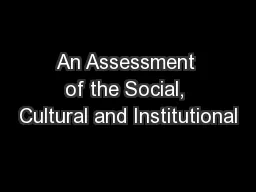

Factors that Contribute to the Sexual Abuse of Persons with Disabilities in East Africa wwwadvantageafricaorg Rob Aley Agnes Musembi Fazira Kawuma David Kariuki Eziekiel Jengo Mary Wickenden Elijah M ID: 585526
Download Presentation The PPT/PDF document "An Assessment of the Social, Cultural an..." is the property of its rightful owner. Permission is granted to download and print the materials on this web site for personal, non-commercial use only, and to display it on your personal computer provided you do not modify the materials and that you retain all copyright notices contained in the materials. By downloading content from our website, you accept the terms of this agreement.
Slide1
An Assessment of the Social, Cultural and Institutional
Factors that Contribute to the Sexual Abuse of
Persons with Disabilities in East Africa.
www.advantageafrica.org
Rob Aley, Agnes Musembi, Fazira Kawuma, David Kariuki, Eziekiel Jengo,
Mary Wickenden, Elijah M
usenyente
, Mary Ann Waddell, (Rebecca McDowall).Slide2
The
motivation
for our research
Failing to get justice
The numerous experiences in the community of trying to assist
survivors of abuse.
Frustrations with accessing support for survivors of sexual abuse.Slide3
The research
activities
Literature and policies review and analysis paper
Research start-up workshop – Kenya (5 days)
Field data collection - Kenya & Uganda
52 semi-structured interviews with individuals and nine focus group discussions across 3 locations.
Primary analysis of data
Mid-project workshop -
further analysis of data (4 days)
Final data analysis
Dissemination of findings
Design of interventions –
applying the findingsSlide4
Literature Review
Persons with disabilities are at increased risk of sexual abuse when compared with the general population (Hughes et. al., 2012; Jones et.al. 2012).
Many survivors suffer multiple violations and many perpetrators commit multiple violations (Save the Children & Handicap International, 2011).
An African study of children with disabilities found that 75% of boys and 25% of girls who reported having been raped felt that nothing had been done about it (African Child Policy Forum, 2005).
Thanks to Mary Ann WaddellSlide5
What the
Literature
Says
Disabled victims of abuse can be female
or male, adults or children
Perpetrators are often people familiar to the victim such as family members, teachers and other carers. Persons with disabilities can also be perpetrators.
Cultural beliefs In East Africa lower the perceived moral threshold around sexual abuse of persons with disabilities
Professionals in education, health, the police and judicial services are often poorly equipped to
provide support and welfare facilities
Slide6
Research Findings
Most incidents of sexual abuse of people with disabilities do not reach the formal justice system.Slide7
The
Survivor
(Barriers to disclosure)
sexual attack on a person with a disability happens
Survivor seeks help
Survivor
Doesn’t
reportSlide8
The
Survivor
(barriers to disclosure)
shame or misplaced guilt
threats
communication
not facilitated
not believed /
valued
fear of demands for moneySlide9
What
happens
in a case of abuse
sexual attack on a person with a disability happens
a proper criminal investigation is initiated
victim receives counselling and good medical services
proper immediate action is taken
victim seeks help
evidence is collected and witnesses cooperate
The survivor feels that they have been supported by the service providers and that justice has been done
a fair trial in court takes place
perpetrator is arrested
Survivor
Doesn’t
report
The survivor receives no services & justice has
NOT
been doneSlide10
What
actually
happens in a case of abuse
sexual attack on a person with a disability happens
immediate action is taken
survivor seeks help
The attack is
reported to family and village eldersSlide11
The
Community
(barriers to disclosure)
local courts mistakenly deal with criminal matters
inappropriate resolutions
petty compensation
fear
of community
shame
fear of jeopardising their own positions Slide12
What
actually
happen in a case of abuse
sexual attack on a person with a disability happens
A local resolution is arranged
Survivor seeks help
The survivor’s needs are ignored s/he feels that justice has
NOT
been done
The attack is
reported to family and village eldersSlide13
The
institutions
(barriers and failures)
‘I don’t think the police have the right training for dealing with the victims and at times they harass and question a disabled person as if they are the perpetrators rather than the victim, which traumatises and stigmatises them even more’. Church Leader.
‘
We have not
been trained specifically on sexual abuse’
Doctor.
Professionals expressed frustration that survivors and their families take a local course of action
‘The investigation officer is sometimes bribed by the accused so that he makes a shoddy investigation which cannot sustain in a court of law and let me tell you that this is very common’
Senior Police Officer.
Coercion and corruption
Inadequate knowledge
and poor practiceSlide14
Our initial
interventions
Advocacy Posters Slide15
Our initial
interventions
Advice bookletSlide16
Our initial
interventions
Drama group raising awareness amongst
community stakeholders including in schoolsSlide17
Thank you
http://www.advantageafrica.org/tackling-sexual-abuse-against-disabled-peopleSlide18
The research
locations